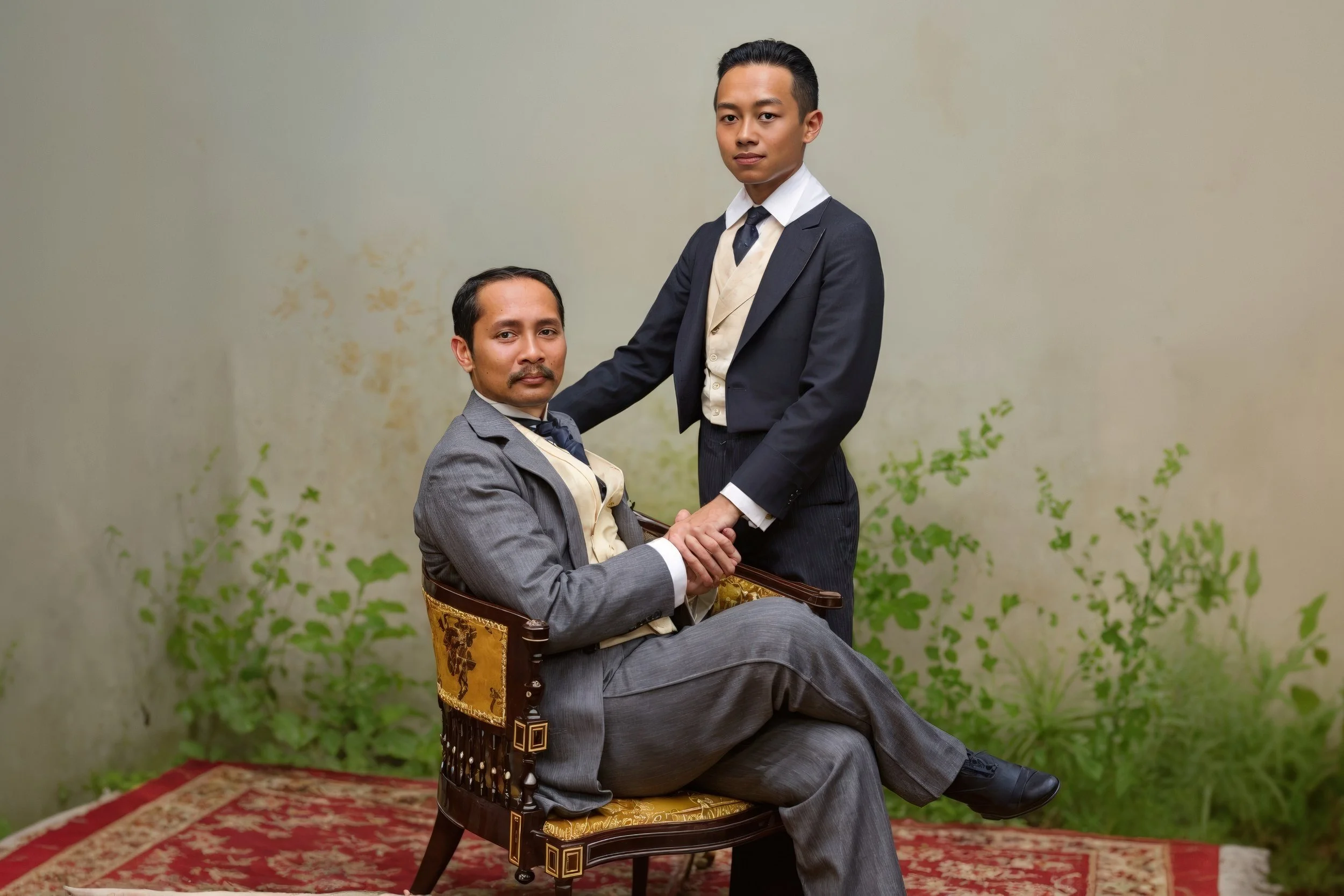พระบรมฉายาลักษณ์ จาก W. & D. Downey กรุงลอนดอน พ.ศ. 2450
พระบรมฉายาลักษณ์ จาก W. & D. Downey กรุงลอนดอน พ.ศ. 2450
พระบรมฉายาลักษณ์ จาก W. & D. Downey กรุงลอนดอน พ.ศ. 2440 (ค.ศ. 1897 ร.ศ. ๑๑๖)
ภาพถ่ายชุดนี้ทั้ง 6 ภาพ เป็นพระบรมฉายาลักษณ์ที่ได้รับการบูรณะด้วยเทคโนโลยี AI เพื่อนำเสนอในรูปแบบสามมิติและมีสีสันใหม่อีกครั้ง ณ ช่วงเวลาสำคัญของประวัติศาสตร์การถ่ายภาพเจ้านายสยาม พระบรมฉายาลักษณ์ดังกล่าวคือ พระบาทสมเด็จพระจุลจอมเกล้าเจ้าอยู่หัว (รัชกาลที่ 5) พร้อมด้วยพระราชโอรสทั้งสองพระองค์ คือ สมเด็จเจ้าฟ้ามหาวชิราวุธ (ต่อมาคือ พระบาทสมเด็จพระมงกุฎเกล้าเจ้าอยู่หัว รัชกาลที่ 6) และ สมเด็จเจ้าฟ้าจักรพงษ์ภูวนาถ กรมหลวงพิษณุโลกประชานาถโดยภาพต้นฉบับถ่ายขึ้นเมื่อปี พ.ศ. 2450 (ค.ศ. 1907) ระหว่างที่พระบาทสมเด็จพระจุลจอมเกล้าเจ้าอยู่หัวเสด็จประพาสยุโรปครั้งที่หนึ่ง และในเวลานั้นสมเด็จเจ้าฟ้าวชิราวุธและสมเด็จเจ้าฟ้าจักรพงษ์ภูวนาถยังทรงศึกษาอยู่ ณ โรงเรียนอีตัน (Eton College) ประเทศอังกฤษ
ภาพถ่ายเหล่านี้บันทึกขึ้นที่สตูดิโอชื่อดังแห่งกรุงลอนดอน คือ W. & D. Downey ซึ่งสามารถสังเกตได้จากชื่อของสตูดิโอที่ปรากฏบนพระบรมฉายาลักษณ์ต้นฉบับ สตูดิโอนี้เป็นช่างภาพประจำราชสำนักอังกฤษและราชวงศ์ยุโรปหลายพระองค์ ก่อตั้งมาตั้งแต่คริสต์ศตวรรษที่ 19 และมีชื่อเสียงด้านความประณีตของฉากถ่ายภาพ การจัดท่วงท่าผู้ถูกถ่าย และรายละเอียดเครื่องแต่งกายอย่างพิถีพิถัน ราชวงศ์อังกฤษ รวมถึงสมเด็จพระราชินีนาถวิกตอเรียและพระเจ้าเอ็ดเวิร์ดที่ 7 ต่างก็ทรงเลือกสตูดิโอนี้ในการบันทึกพระฉายาลักษณ์อย่างเป็นทางการ จึงอธิบายได้ว่าทำไมเจ้านายสยามจึงทรงเลือกใช้บริการของสตูดิโอแห่งนี้เช่นกัน
รายละเอียดเครื่องแต่งกายในภาพสะท้อนถึงแฟชั่นและสถานะทางสังคมในยุคนั้น พระบาทสมเด็จพระจุลจอมเกล้าเจ้าอยู่หัว ทรงฉลองพระองค์ ชุดสูทสามชิ้นแบบวิคตอเรียนตอนปลาย (Late Victorian three-piece suit) แบบเสื้อโค้ทหางโค้ง (morning coat) และ ปกแข็งแบบ Imperial collar คู่กับผ้าพันคอคราเวท (cravat) ซึ่งเป็นธรรมเนียมสุภาพบุรุษชั้นสูง ขณะที่สมเด็จเจ้าฟ้ามหาวชิราวุธ และสมเด็จเจ้าฟ้าจักรพงษ์ภูวนาถ ทรงฉลองพระองค์พร้อม ปกเสื้อแบบ Eton collar อันเป็นเอกลักษณ์ของนักเรียนโรงเรียนอีตัน และธรรมเนียมเฉพาะของบุตรหลานชนชั้นสูงในวัยไม่เกิน 18 ปี ความแตกต่างนี้สะท้อนถึงพระชนมายุและบทบาทที่แตกต่างกันของทั้งสามพระองค์ อีกทั้งยังช่วยยืนยันช่วงเวลาแห่งการถ่ายภาพในช่วงปลายคริสต์ศตวรรษที่ 19
พระบรมฉายาลักษณ์ชุดนี้จึงไม่เพียงเป็นหลักฐานของการที่สยามมีส่วนร่วมกับการศึกษาและวัฒนธรรมตะวันตก หากยังสะท้อนความมุ่งมั่นของราชวงศ์จักรีในการธำรงไว้ซึ่งพระเกียรติยศและศักดิ์ศรีบนเวทีนานาชาติ การบูรณะด้วยเทคโนโลยี AI ทำให้เราสามารถชื่นชมพระบารมีและพระอิริยาบถของทั้งสามพระองค์ได้อีกครั้งหนึ่ง ท่ามกลางห้วงเวลาที่โลกกำลังเปลี่ยนผ่านสู่ความทันสมัย
งที่น่าสนใจเกี่ยวกับภาพถ่ายชุดนี้คือ พระบรมฉายาลักษณ์คู่ของพระบาทสมเด็จพระจุลจอมเกล้าเจ้าอยู่หัวและสมเด็จเจ้าฟ้ามหาวชิราวุธ ปรากฏออกมาในหลายลักษณะ ทั้งในมุมกล้องและท่วงท่าที่แตกต่างกันถึงสามแบบ ขณะที่ในสื่อกระแสหลักมักเผยแพร่เพียงภาพเดียวเท่านั้น เช่นเดียวกับ พระบรมฉายาลักษณ์เดี่ยวของพระบาทสมเด็จพระจุลจอมเกล้าเจ้าอยู่หัว ซึ่งมีอยู่สองมุมกล้องในท่วงท่าเดียวกัน ภาพทั้งหกนี้อาจเป็นเพียงส่วนหนึ่งของชุดภาพที่ถ่ายขึ้นจริงในคราวเสด็จครั้งนั้น และยังมีความเป็นไปได้ว่าอาจมีภาพเพิ่มเติมที่ยังไม่ได้ถูกค้นพบ ดังนั้นการศึกษาต่อไปจึงจำเป็นต้องอาศัยการวิจัยอย่างละเอียด รวมทั้งการปรึกษานักสะสมและพิพิธภัณฑ์ต่าง ๆ เพื่อสืบค้นและทำความเข้าใจภาพถ่ายในครั้งประวัติศาสตร์นี้อย่างรอบด้าน
Siamese Royal portrait by W. & D. Downey, London, 1907
This set of six photographs has been AI-restored to present them once again in three-dimensional form and vivid colour, capturing an important moment in the history of Siamese royal portraiture. The images depict King Chulalongkorn (Rama V) together with his two sons, Prince Vajiravudh (later King Vajiravudh, Rama VI) and Prince Chakrabongse Bhuvanath, Prince of Phitsanulok Prachanat. The original portraits were taken in 1907, during King Chulalongkorn’s second visit to Europe, at a time when both princes were still studying at Eton College in England.
These portraits were taken at the renowned London studio W. & D. Downey, as can be seen from the studio’s imprint on the original photographs. Downey was the official photographer to the British royal family and several European courts. Established in the 19th century, the studio was famed for its refinement, carefully arranged compositions, and meticulous attention to costume detail. Members of the British royal family, including Queen Victoria and King Edward VII, frequently chose Downey for their official portraits, which explains why the Siamese royal family also selected this prestigious studio.
The attire in these portraits reflects both the fashion and social status of the time. King Chulalongkorn is dressed in an Edwardian three-piece suit, featuring a curved-tail morning coat, combined with an imperial stiff collar and a cravat, hallmarks of elite Edwardian menswear. In contrast, Prince Vajiravudh and Prince Chakrabongse Bhuvanath wear the distinctive Eton collar—a wide, starched collar with pointed tips, traditionally reserved for Eton students and symbolising the upbringing of aristocratic boys under the age of eighteen. This distinction not only reflects their age and roles but also firmly situates the portraits in the early 20th century.
These royal portraits serve not only as evidence of Siam’s engagement with Western education and culture but also as a reflection of the Chakri dynasty’s determination to uphold its dignity and prestige on the international stage. Thanks to AI restoration, we can once again appreciate the presence and bearing of the three royals, captured at a pivotal moment when the world itself was moving towards modernity.
What is particularly interesting about this set of photographs is that the double portraits of King Chulalongkorn and Prince Vajiravudh appear in three different versions, with variations in camera angle and pose, while in mainstream publications only one of these images is usually seen. Likewise, the single portraits of King Chulalongkorn exist in two different camera angles of the same pose, though generally only one is widely circulated. These six photographs may represent only a portion of the full series taken during that royal visit, and it remains possible that additional images have yet to be discovered. Further study will require more extensive research, as well as consultation with collectors and museums, in order to uncover and better understand the full scope of this historic photographic record.
#aifashionlab #AI #aiartist #aiart #aifashion #aifashiondesign #aifashionstyling #aifashiondesigner #fashion #fashionhistory #historyoffashion #fashionstyling #fashionphotography #digitalfashion #digitalfashiondesign #digitalcostumedesign #digitaldesign #digitalaiart #ThaiFashionHistory #ThaiFashionAI #thailand #UNESCO

















